For those who are interested in the history of the LEGO company, there is a fantastic new resource directly on LEGO’s website. The LEGO History page can be accessed at lego.com/themes/lego-history, which is kind of an odd positioning that’s hard to find, but once you get there, you will be greeted with a treasure-trove of fascinating historic facts, figures, and stories, as well as lots of lovely old photos. 🙂
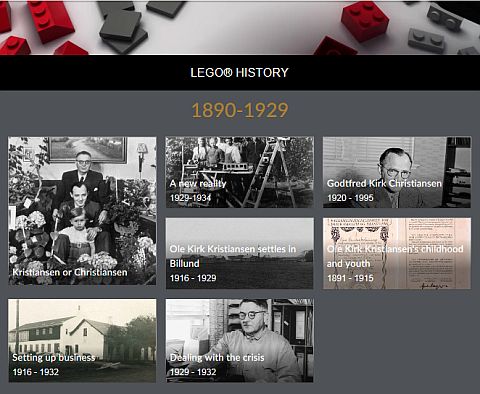
Please note that the new LEGO History page is not the same as the LEGO History Timeline that has been around for some time and can be found at lego.com/aboutus/lego-group/the-lego-history. This page is also a great resource, but not as extensive as the new LEGO History page.
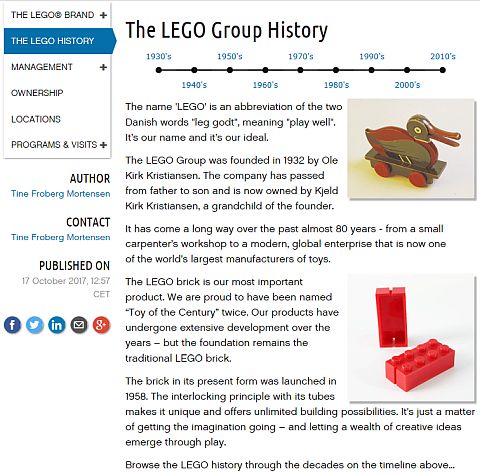
The LEGO History page is divided into sections by decades, with old black-and-white photos as cover images for the chapters. You can click on each image to reveal more information, as well as more pictures. For example, if you click on the first image under the 1890-1929 section, you can read about how the founder of the LEGO company, Ole Kirk Kristiansen spelled his name both as Kristiansen and Christiansen, and his descendants also used both versions of the name (usually favoring one spelling over the other). Other chapters under this section cover Ole Kirk’s childhood and youth, starting a family, and setting up a woodworking business. The historical context from this period is also covered. There are even journal entries from Ole Kirk himself, where he writes about the difficulties faced after the 1929 Wall Street stock market crash. Again, each of the sections includes more old photos from these early days.
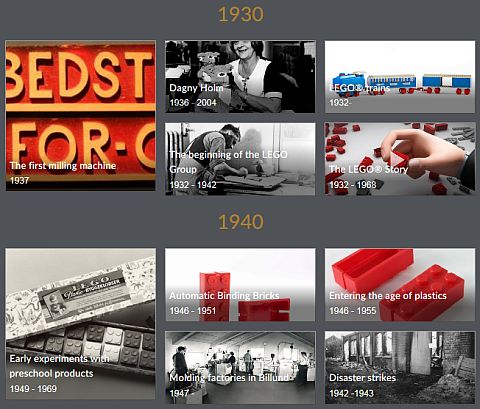
The 1930s section tells more stories about Ole Kirk, including buying the first milling machine for his woodworking business (a very innovative and expensive piece of equipment at that time). There is an entire chapter dedicated to the creative work of Dagny Holm Jensen, the niece of Ole Kirk, who worked for the company in its early days (when it was still making wooden items), and many years later became instrumental in adapting to plastics, and also in creating the first models for LEGOLAND. There is also a chapter covering LEGO trains; from the early wooden trains, to the first LEGO brick trains.
The section on the 1940s discusses early experiments with pre-school products, the first automatic binding bricks, the first plastic moulding machines in Billund, and more. By the 1950s, the company is completely invested in working with plastics, and tests out and adapts new technologies and manufacturing processes. You can read about mould production, expanding production to other countries, and more. Both of these sections are very interesting.
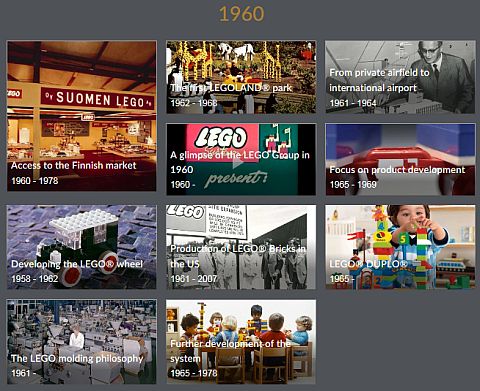
The 1960s and 1970s sections have lots of chapters covering the growth of the company, including expanding manufacturing, packaging, and distribution to other countries outside of Denmark, further developing and refining the LEGO building system, the introduction of the LEGO minifigure, and the beginning of still beloved classic themes like LEGO Castle and LEGO Space. Even if you are fairly familiar with LEGO’s history, I highly recommend checking out these chapters, as it includes lots of information I don’t remember reading anywhere else.
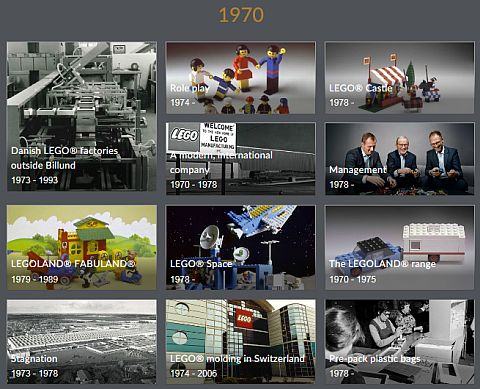
The section on the 1980s and 1990s covers new management strategies, new factories in South Korea, Brazil, and the Czech Republic, and the introduction of LEGO Education. Again, lots of very interesting information here about the ups and downs of managing the company.
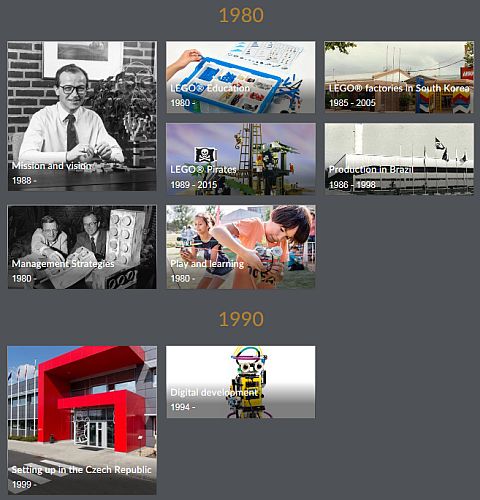
The last couple of sections cover the year 2000 to date. One of the most interesting chapters (at least to me) is about LEGO outsourcing some of its manufacturing to Flextronics for a few years. There are also chapters on the new manufacturing facilities in Hungary, Mexico and China. Separate chapters are dedicated to the LEGO Vikings and LEGO Architecture lines.
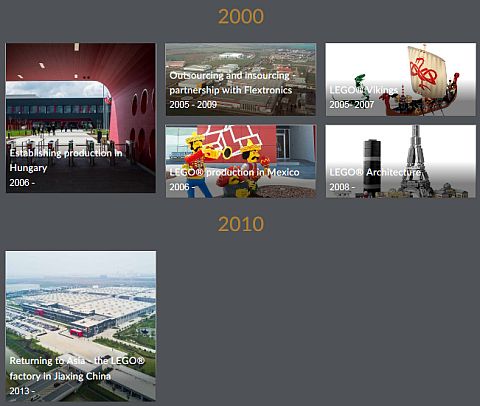
In summary, the LEGO History page is a fantastic resource! If you like to learn about LEGO’s history, as well as getting insights into the management, manufacturing, distribution, and other nuances of running the largest toy company in the world, I think you will be thrilled with these pages.
What do you think? Are you interested to learn about LEGO’s history? Did you find any information at the LEGO History website that you didn’t know previously? What else would you like LEGO to share on these pages? Feel free to share and discuss in the comment section below! 😉
And you might also like to check out the following related posts:
- The Story of the LEGO Minifigure – Part 1
- The Story of the LEGO Minifigure – Part 2
- The Story of the LEGO Minifigure – Part 3
- The Story of the LEGO Minifigure – Part 4
- The Story of the LEGO Minifigure – Part 5
- LEGO 60th Anniversary Sets & Promotions
- 60 Years of the LEGO Brick Anniversary Set
- The Origins & Predecessors of LEGO Bricks
- The Secret World of LEGO – Documentary
- All Basic LEGO Bricks in My Day – Is It True?
- How Much Do You Know About LEGO?












Finally! I’m surprised LEGO didn’t do this before. I just started reading, and there is so much good info. But why did they put it under themes? When you go to themes, you can no longer access it. So unless you have the direct link you can’t access the page. Anyway, I will bookmark it.
Not sure about the positioning of this page. I did find it strange too. Yes, best is to bookmark it so you can go back. 🙂
This looks like a great website! I really like the photos. Thanks for sharing this. I would have probably never found it on my own.
You’re very welcome. Have fun reading! 😀
This is a wonderful page! I love the layout and that they used all those old photos. I plan to go through the whole thing. So much treasure! The early years and the growing years are especially interesting to me.
Hmmm, I’d say the most significant oversight is Technic, which both was a game-changer and still is a popular line.
I could only find a brief footnote in the “Further development of the system”, but maybe another article, and something about the various CCBS systems, could come up later.
I’m sure they are still working on adding more info. LEGO has such a rich history, there is so much more that can be added. 🙂
This is great. Admin, just curious, how did you even find it? It’s not evident anywhere on Lego’s homepage that this section of the website even exists.
It was mentioned on the Ambassador Forum in one of the discussions. It was a delightful surprise to everyone. 😀
Look at how far Lego has come and they still keep on coming. Two Lego mini figure claw hands up.👍Lol!
Awww… that’s cute! 😀
WOw! I love this! It looks like a great resource for students and history buffs. I hope they will continue adding more information and stories.
I didn’t see Modulex being mentioned. I hope they add that as well. It was almost revived a couple of years ago. But then it vanished again.
Seems like Modulex didn’t survive that long in its original incarnation as a tool for assisting architects (due to it ultimately being too unflexible and impractical), and quickly more or less degenerated into a simpler planning tool with lettered bricks. It’s also somewhat of a niche curiosity, even among its fanbase.
(It seems TLG bought up the Modulex company more for historical reasons than for economic gain, similar to how Disney bought back the rights to the Oswald the Rabbit character a while back.)